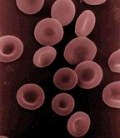Salmonella bacteria use RNA to assess and adjust magnesium levels, according to researchers at the Washington University School of Medicine in St. Louis. Eduardo Groisman and colleagues at WUSTL have added a new gene to the bacterium via a mechanism known as the riboswitch.
Riboswitches were first identified in 2002 and sense when a protein is needed and stop the creation of the protein if it isn’t. A riboswitch, does not rely on anything binding to DNA; instead, the switch is incorporated into messages for construction of proteins. These messages are protein-building instructions copied from DNA into strands of RNA. The riboswitch is a sensor within the RNA that can twist it into different configurations that block or facilitate the production of the protein encoded in the message.
Previously identified riboswitches respond to organic compounds such as nucleotides and sugars. The Salmonella riboswitch, reported on Friday in Cell, responds to magnesium ions, key elements in the stability of cell membranes and reactants in an energy-making process that fuels most cells.
“Magnesium ions are essential to the stability of several different critical processes and structures in the cell, so there has to be a fairly intricate set of regulators to maintain consistent levels of it,” says senior investigator Groisman, “To approach such a complex system, we study it in a simpler organism, the Salmonella bacterium.”
Groisman and his colleagues uncovered the magnesium riboswitch while they were investigating the MgtA gene, which is controlled by the major regulator of Salmonella virulence, the phoP/phoQ system. The MgtA gene codes for a protein that can transport magnesium across the bacterium’s cell membrane. Groisman’s group showed 10 years ago that the phoP/phoQ system controls when Salmonella makes MgtA.
You can read more about the work at the WUSTL site.
 A, B, AB, or O?
A, B, AB, or O?